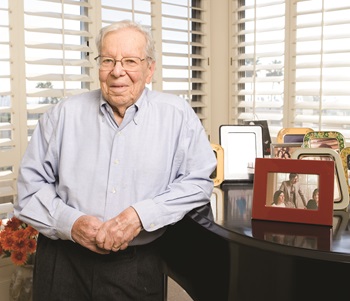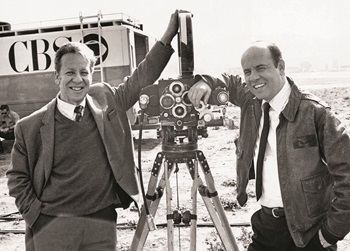BY DAVID GEFFNER
 LOOKING AHEAD: Singer could save his director time by getting the crew
LOOKING AHEAD: Singer could save his director time by getting the crew
ready to move locations with the next to last shot. (Credit: Brian Davis)
Long before there was the "Abby Singer," the widely recognized shorthand on sets for the second-to-last shot of the workday, Harlem-born Abner E. "Abby" Singer was learning production management the old-fashioned way.
"I got out of the Navy in 1945, and my first job in the business was for Jack Fier, head of production at Columbia Pictures and second in command to Harry Cohn," the 93- year-old assistant director and UPM says from his Beverly Hills apartment. "They called him 'Black Jack' Fier and he was a killer—the toughest cookie around."
In fact, the famously tightfisted studio kept tabs on each of its productions via direct phone lines to all of its stages and locations. So, as Fier's assistant, Singer was required to listen in on the dozens of daily conversations Fier had with his ADs and directors, most of which ended in profanity-laced tirades telling them to keep shooting or else.
"We were doing a Western at the Iverson Ranch [in the north San Fernando Valley]," Singer begins, "and the assistant director called Jack's office to say Ray [director Raymond Nazarro] won't shoot because it's too cloudy. I get Ray on the phone and Jack says, 'Tell me, Ray, are you wearing a hat? Ray says, 'Sure Jack.' 'Do me a favor and hold it out where you can see it. Can you see it, Ray? And Ray says, 'Sure Jack, I can see it.' 'Then start shooting right now you [expletive deleted].' "
Singer chuckles remembering another well-known Fier incident: "When Orson Welles put up a sign [on the set of The Lady from Shanghai] that read: The Only Thing We Have to Fear Is Fier Himself."
Nonetheless, Fier repaid Singer for his three years of hard work and loyalty by making him one of only two designees from Columbia in 1949 to join the Screen Directors Guild. "We were the only studio that did not use unit or location managers," Singer continues. "So the ADs at Columbia were kept very busy. I worked with Laslo Benedek on Death of a Salesman with Fredric March and The Wild One with Marlon Brando, who was just a young kid at the time. In 1952, I asked Jack to move me over to television as my first wife was ill at the time and I needed to stay in town."
In 1957, Singer took a job with Universal to focus exclusively on TV. That's where he believes his namesake shot was first coined. "It was probably on Wagon Train, although I can't be sure," he says. "Working in TV we made many moves per day—from the back lot to the stage, or from one stage to another. I'd say to the guys, 'One more shot and then we're moving,' so when we moved, they were all prepared. The time saved could add up to a full hour of shooting for the director."
Although he's not certain where it started, the Abby Singer shot has since taken on a life of its own. "It caught on like lightning. I was hearing it all the time," he remembers. "They said, 'You're famous.' I said, 'I'm not famous.'"
The shot has indeed given him a certain celebrity. His face has been put on T-shirts designed for crews, and the Robinson Film Center in Shreveport, La., is home to Abby Singer's Bistro. While traveling in Israel, Singer came across a crew shooting at a restaurant where he was eating. "I was talking to the cameraman," he recalls. "I said, 'I'm Abby Singer.' He said, 'Stop it!' He had the crew come over to meet me."
There is even a building on the Sunset Gower lot (where Columbia Pictures started) dedicated to Singer. A plaque on the side reads, in part, "Abby became legendary by creating one of the most famous lines uttered by filmmakers around the world. 'This shot and one more'… signaling to crew and management that the end of the workday was near … Today, as in days past, scores have said, 'We're on the Abby Singer.'"
 GET READY: Singer (left), on the set of The Tim Conway Show with its star at the CBS
GET READY: Singer (left), on the set of The Tim Conway Show with its star at the CBS
Studio Center, says he isn't sure where his famous shot started. (Credit: Abby Singer)
But before getting to the penultimate shot, Singer understood there was a lot of work to be done. His skill overseeing TV budgets and crews at Universal led him to The Doris Day Show where he was the UPM from 1968-1971. After that he moved to MTM Productions as head of production for 11 years. "We were the Tiffany of the television world," he says about his time with Mary Tyler Moore and Grant Tinker's hit factory. "Rhoda, Phyllis, The Bob Newhart Show, WKRP in Cincinnati, The White Shadow, Hill Street Blues, St. Elsewhere—it was an amazing run of shows!"
Describing his role at MTM as a "factory superintendent" caught between two worlds, Singer says he "reported to the top brass upstairs but I was also in charge of the people on the set. The biggest key was honesty; I never lied to anyone. Ever."
Sometimes that put him in a tight spot. He remembers an incident with Suzanne Pleshette, who played Newhart's wife on the series. "Her wardrobe lady bought a $1,000 dress for her, which was a lot of money in those days, without getting approval," Singer recalls. "I chewed her out and then later I got a call [from Pleshette] asking me to come down to the set. She said, 'You know, Abby, you're the new VP at MTM. A vicious prick!' After we stopped laughing, I said, 'I'm just watching out for your money,' and she agreed."
Although Singer says he loved taking care of other people's money, his biggest source of pride (outside of his wife and children) has been being a part of the DGA family. Throughout his long career, Singer served on the AD Council, on various bargaining committees, and in 1985 he received the Frank Capra Achievement Award for his contributions to the Guild. "The Guild is the best thing that ever happened to me," he beams. "It raised the cost of living from peanuts to terrific salaries. And the health and welfare have been incredible; it really watches out for its members."
Not long after Singer's last UPM job in 1997, he began teaching at the American Film Institute Conservatory, work that he continues to this day.
"I tell students how they can save money on their projects, and help them get crews and equipment," he says. "We only shot on film in my day but I urge them to shoot HD because that's today's technology. I get very basic questions. For instance, their scripts will call for shooting a house on the street in one of the canyons, and I'll say, 'Traffic will kill you. Move the scene to a more practical, and cost-effective, location.'"
Besides teaching, Singer continues to meet with his old pals from Columbia every week, trading stories, new and old. Their hangout of choice is Art's Deli in Studio City, not far from the old MTM lot.
"We call it the ROMEO group," he says with a grin. "Retired Old Men Eating Out. Only one guy out of the seven likes retirement—the rest of us would still be working if we could."